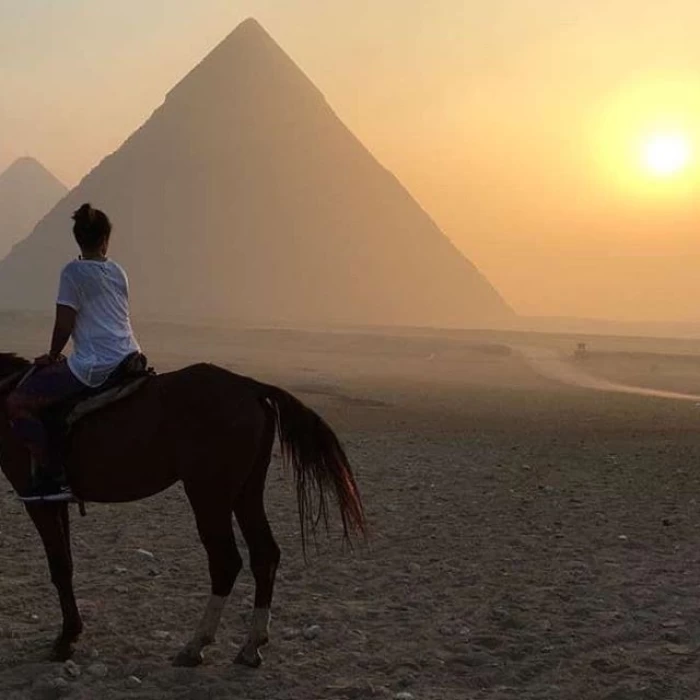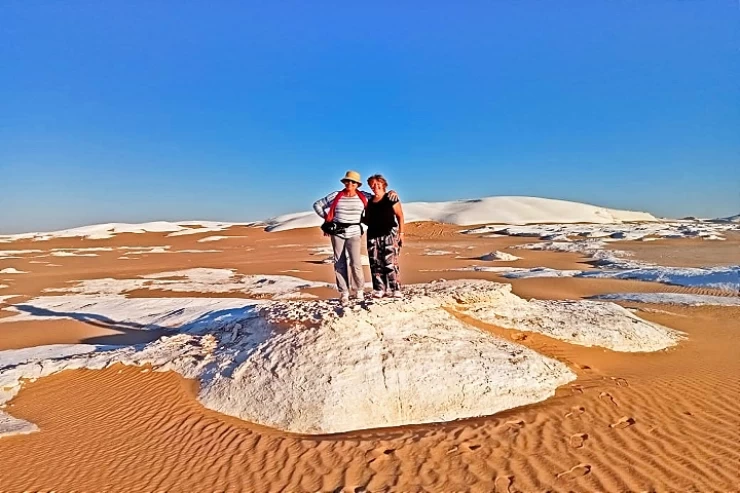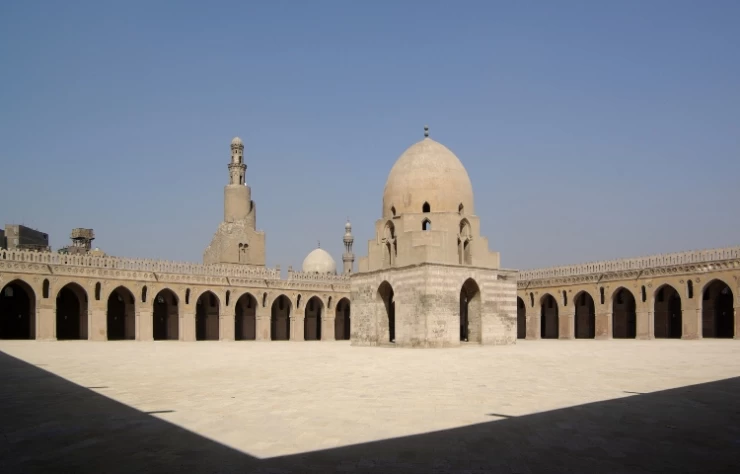
Egyptian History
Egypt is one of the oldest civilizations in history (4000 BC).
Archaeological studies have shown that humans have inhabited Egypt since the beginning of the Paleolithic era, and a comparative study of skulls dating back to pre-dynastic times (4000 BC)
Paleolithic Periods
Researchers have divided the Paleolithic into three eras due to their length (Paleolithic, Mesolithic, and Neolithic).
Paleolithic (2300000-100000 BC)
Researchers found traces of the first era in the Egyptian deserts, or in the hills near the Nile Valley, and it consisted of stone axes, some of which were polished so that the axe had three faces.
Their general shape is pyramidal.
Middle Stone Age (12000 to 8000 BC)
This era is considered a transitional period between the Paleolithic and Neolithic periods, and among the relics of this era are sharp stone tools that varied in their geometric shapes.
Neolithic Age: 8000 to 3200 BC
In this era, drought dominated the ancient Arabian Levant, which prompted the ancient Egyptian man to learn agriculture to provide food for himself, so the ancient Egyptian man migrated to the Nile Valley and the Delta to provide a suitable environment for agriculture.
Dynastic era
The Kingdom of Upper Egypt wanted to unite with the Delta Kingdom, so it fought many harsh wars, finally culminating in the unification of the two kingdoms.
The first transition period
The kings of this state built great pyramids, gave priests lands, and exempted them from many duties, which burdened other Egyptian groups.
The Middle Kingdom
King Mentuhotep II, the founder of the Eleventh Dynasty, is considered the greatest king of this dynasty, as he restored the unity of Egypt, protected its eastern borders, and built a temple and cemetery to the west of Thebes.
The Modern State Era
The modern Egyptian state is one of the greatest states in ancient Egypt. It is not an exaggeration to say that every person has an era of heroism, and the era of heroism of Pharaonic Egypt was realized after the establishment of the modern state; the Egyptians built an empire that stretched from the Euphrates in the north to Sudan in the south.
Persian control of Egypt
The Persians took control of Egypt in 525 BC under the leadership of King Cambyses until Alexander of Macedon defeated them at the Battle of Issus.
Roman Egypt
Octavius became the master of Egypt and declared Egypt a Roman state linked to the person of the emperor. He set a special regime for it, making it forbidden for any senator or high-ranking politician to visit Egypt without the emperor's approval.
All this produced a historical inevitability, which was reflected in the events of the Arab Levant from the beginning of history until today, as no great event occurred in the Levant without being influenced or affected by it.
The Islamic conquest of Egypt
Amr ibn al-'As settled in Palestine until he felt the urgent need to conquer Egypt to secure the Levant from the Byzantine threat perched on the land of Egypt, so he asked Caliph 'Umar ibn al-Khattab for permission to conquer it, and after hesitation, Amr went there.
Ottoman Egypt
After the death of Sultan Qansuh al-Ghuri, the Egyptians pledged allegiance to Touman Bey as Sultan of Egypt. Sultan Selim I offered him the rule of Egypt on the condition that he recognize his dependence on the Ottoman Empire, but Touman Bey refused to be subordinate to the Ottoman Sultan, so the Ottomans, led by Sultan Selim, headed to Egypt and met with the Mamluks and defeated them at Ridaniya in 1517, and Selim I entered Cairo victoriously, and he preached to him on its pulpits, and from that time on, Egypt became an Ottoman state, which was ruled from the Ottoman side by Khair Bey, who betrayed his king Al-Ghuri in the battle of Marj Dabiq. The Ottomans remained in Egypt until the declaration of the British Protectorate in 1914, a long period that can be divided into four stages.
French invasion
The French campaign arrived in Egypt and the southern Levant, and one of its direct results was that it brought the region out of its long isolation and aroused the interest of Westerners not only in Egypt but in all the countries of the Arab region.
British occupation
Lord Cromer became the de facto ruler of Egypt. As for Egypt's relationship with the Ottoman Empire, it was agreed between Britain and the High Council that the British presence in Egypt was only a temporary presence aimed at establishing order and stabilizing the authority of the state represented by the Khedive until Egypt gained its full independence in 1934.
The ancient history that can be perceived from the Pharaohs has to be one of the greatest historical civilizations ever. Its events’ timeline is well over five thousand years, and many aspects of the world, such as art, architecture, culture, and even religion, have their bases in Egypt. The records of the land of Egypt are interesting in that they contain histories of empires that were built and then perished, histories of great kings and queens, and outstanding places and structures that even today, in modern societies, can only marvel at. Egypt’s history is undoubtedly dominated by a vibrant narrative of struggle, hope, and ingenuity of the people portrayed, from the making of the pyramids to the currents of the Nile.
The Ancient Kingdoms of Egypt (c. 3100 BC–332 BC)
1. Pre-Dynastic Period (Before 3100 BC)
The elements of history written of Egypt are dated around 3100 BC, but if one avails of its importance in terms of history, it dates back even to the pre-dynastic era, when there was the emergence of small agricultural settlements along the Nile. By this time, the early residents of Egypt were busy establishing forms of agriculture as well as animal husbandry, pottery making, and the making of crude tools. These settlements served as the foundation of the elaborate systems of culture and society that were to come.
2. The Unification and Early Dynastic Period (c. 3100–2686 BC)
King Narmer, often referred to as Menes was responsible for the unification of Upper and Lower Egypt, which signified the onset of ancient Egyptian civilization. He is considered to be the first pharaoh of Egypt and founded the nation’s first dynasty. This unifying act was essential since it created the nucleus around which the centralized monarchy of Egypt, which was the prevailing system of government for almost three thousand years, would revolve.
Towards the tail end of the Early Dynastic, the very first steps in the construction of monumental architecture began, and hieroglyphs were mastered. It was in this period that the rulers were expected to fulfill the role of the king and also that of a god. This idea existed for many years and was a fundamental one in Egypt.
3. The Old Kingdom (c. 2686–2181 BC)
The divine rulers, who were the Pharaohs in the earthly realm, tamed every resource and manpower to erect huge structures such as the Great Pyramid of Khufu and the Sphinx.
The Old Kingdom period displayed a clear and consistent administrative hierarchy and even a large-scale institutional support system that controlled the resources, agricultural production, and the temples of the state. However, in the latter years of this era, the dominant position of the central authority began to diminish, ushering in an era of chaos and fragmentation.
4. The Middle Kingdom (c. 2055–1650 BC)
Following the tumultuous First Intermediate Period referred to, Egypt returned to political stability and strong rulers in its Middle Kingdom. There is a revival in this period in the fields of art, literature, and monumental building works. Pharaohs such as Mentuhotep 11 and Senusret 111 were responsible for extending Egypt’s boundaries southward into Nubia as well as promoting relations with other countries through trade.
The Middle Kingdom is usually regarded as the classical period of ancient Egypt, filled with relative calm and wealth. The authorities emphasized the development of construction and the growth of the economy of Egypt. In spite of such achievements, the internal conflicts and external challenges finally caused the disintegration of the Middle Kingdom, making way for another period of darkness and despair.
5. The New Kingdom (c. 1550–1070 BC)
The new kingdom constitutes, also from a chronological point of view, the culminating era of ancient Egyptian civilization. It was during this period that Egypt was transformed into a full-fledged empire under rulers such as Thutmose III, Hatusu, and Rameses II, who through wars and conquests, or rather political strategies, expanded Egypt's borders. He also added great temples during this period, such as those at Karnak, Luxor, and Abu Simbel, many of which still exist today.
Il nuovo regno era un’epoca che riformò anche la religione in notevoli modi, come il periodo di regno del faraone Akhenaten, which introduced a period of continuous fight in worshipping a single god—Aten, the disk of the sun. His was, however, an unpopular and a very brief rule, for there were leaders after him who brought back the old ways of worship in Egypt, which was worshiping none but many gods.
But then, power aside, Egypt was not immune to the laws of history. By the close of the New Kingdom, this state institution in question was already wobbly, and there was a gradual abatement of its activities.
1. The Ptolemaic Dynasty (332–30 BC)
For many centuries, the old state of Egypt thrived free until that point in time, which altered when the rule of Alexander the Great started in the year 332 BC. It was also during those years that Alexandria became the center of Greek civilization and education, with the noted Library of Alexandria and the Lighthouse, which is now one of the Seven Wonders of the Ancient World.
Until the end of the dynasty, the traditions of Egypt were largely maintained, even though the rulers were Hellenistic kings. The last ruler of this dynasty, Cleopatra VII, was known to have opposed the domination of Rome by trying to establish relations with Julius Caesar and Mark Antony. However, after her loss at the Battle of Actium in 31 BC, Egypt fell into the Roman Empire.
Under the control of the Romans, Egypt was considered one of the most valuable provinces of the empire, primarily because it was rich and produced plenty of crops, particularly grains. The Romans maintained several of the practices of the Ptolemaic kings; however, Egypt was administered as a colony of the empire. The establishment of Christianity in Egypt started during the Roman times, and it was in the 4th century A.D. that Egypt began to develop into a significant early center of Christianity.
The phase change from the Roman to the Byzantine Empire that occurred in 395 AD marked the slow deterioration of Egypt’s economic well-being, but Egypt was still geographically and religiously active. It was also in this time period that the popular Coptic Church was born, which incorporated aspects of Christianity with ancient Egyptian beliefs.
The Egyptian territories fell to the Army of Islam in the year 642 AD. This marked the commencement of the Islamic Era in Egypt. As Cairo, a city created by the Fatimids in 969 AD, grew prominent, it was clear that Egypt was going to become one of the most pivotal countries in the Islamic world. After most of the Egyptian lands were conquered, Egypt witnessed great prosperity in learning, trade, and the arts.
The Fatimids, Ayyubids, and Mamluks
The capital of Egypt was established, and the famous Al-Azhar University was built during the reign of the Fatimid Dynasty which ruled over Egypt. With the waning of the Fatimid era, Egypt was captured for a brief period by the fact that Saladin, protector of the territories, including Egypt himself, later founded the Ayyubid dynasty, whose main task was fighting against the Crusaders.
Later came the Mamluks, who were a military caste and who ruled over Egypt for several eras. They built a number of the most beautiful structures in the city, including mosques, schools, and fortifications, in the Mamluk period. Egypt was, at least at the stage when it was defeated, a rather big country with advanced development before it was conquered by the Ottoman Empire.
Egypt in the Modern Era (1517–Present)
1. Ottoman and British Rule
With the Ottoman Empire's conquest in 1517, Egypt was annexed as part of the empire for nearly four hundred years and had remained so bound. That is primarily due to its geopolitical possibilities; it was invaded several times by European powers, and in 1798 Napoleon Bonaparte managed to invade Egypt for a short period. After the French lost in this region, Egypt was ruled by Muhammad Ali Pasha, who was on modern Egypt’s compass. He reformed agriculture, industry, and the military; these transformations served as the waking up of the modern state of Egypt.
In the late nineteenth century, Egypt acquired the status of a British protectorate, which lasted until ’52, the year Egypt resumed control after a revolution led by Gamal Abdel Nasser. It was Nasser who became one of the most powerful figures within the Arab sphere of influence, propagating pan-Arabism and earlier nationalizing the Suez Canal in 1956.


















